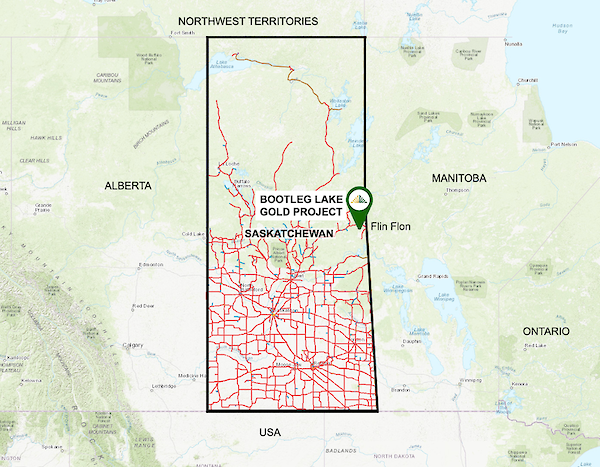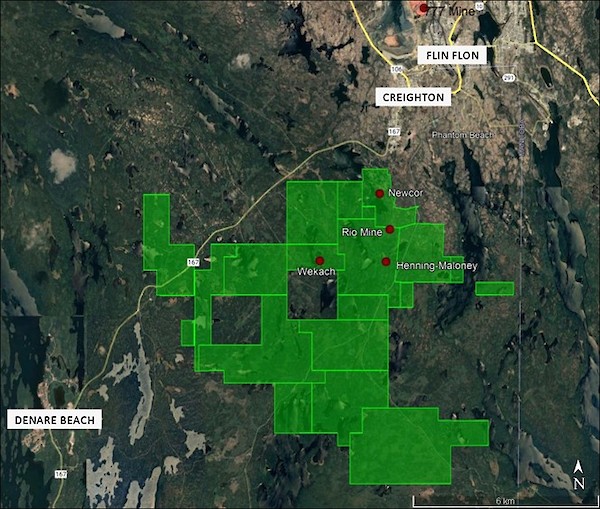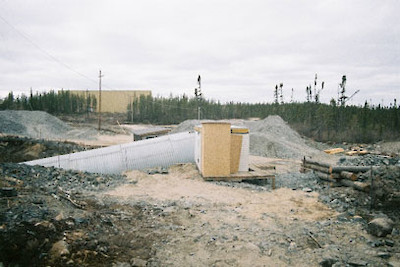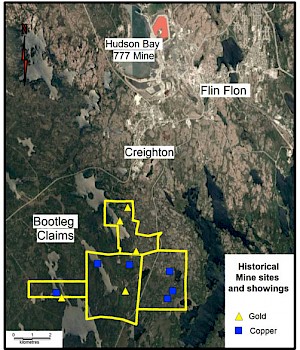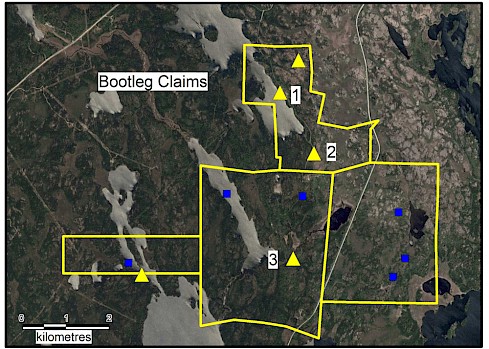Highlights
- High Grade Gold and VMS targets in Saskatchewan near Flin Flon area, nearby Hudbay 777 Mine
- 18 claim blocks covering 49.4 sq km.with core claims in good standing until 2040
- Three past producing gold mines with historical resources: Bootleg/Rio Mine, the Henning Maloney Mine and the Newcor Gold Mine
- 1,500 metres of underground workings which can reopened
- Grab samples results of up to 183 g/t Au at Rio Mine and 86 g/t at Henning Maloney
- Searchlight Resources holds 100% ownership
Location
The Bootleg Lake Gold Project is located near Creighton, Saskatchewan, Canada – five kilometres southwest of the city of Flin Flon, Manitoba. Flin Flon is a major mining centre within the Flin Flon Snow Lake Greestone Belt.
In July 2017, Searchlight Resources staked a total of 13 claim blocks covering 2,851 hectares contiguous to south and west side of the original Bootleg Lake claims. With the new staking, the present total area is 3,718 hectares or 37.18 square kilometres – a 329% increase in area.The original property consists of 4 contiguous claims totalling 867 hectares hosting four past producing gold mines, Bootleg/Rio Mine, Henning Maloney Mine the Newcor Gold Mine and the Wekach Mine.Three of these deposits have historical estimates calculated by Vista Mine Inc. in the mid 1980’s. (See table below.) In addition to the known deposits there are a number of additional gold and copper occurrences on the claims.
Historical Resource Estimates
| Historical Estimates of Bootleg Lake deposits | |||||
|---|---|---|---|---|---|
| Deposit | Category | Tons | Tonnes | Oz/ton | Grams/tonne |
| reported | calculated | reported | calculated | ||
| Bootleg (Rio) | Reserves | 183,871 | 166,800 | 0.35 | 12.0 |
| Henning Maloney | Proven | 15,000 | 13,600 | 0.45 | 15.4 |
| Possible | 43,000 | 39,000 | 0.16 to 0.32 | 5.5 to 11.0 | |
| Newcor | Proven | 42,500 | 38,600 | 0.31 | 10.6 |
| Probable | 156,000 | 141,500 | 0.31 | 10.6 | |
|
1) All historical estimates above were prepared by Vista Mines Inc, in 1983 through 1987. 2) Note the historical estimate used the terms historical reserves, historical proven and possible reserves and historical proven and probable reserves were prepared before the introduction of National Instrument 43-101-Standards of Disclosure for Mineral Projects These historical estimates are considered relevant as the Company uses historical reports to evaluate historic mines as a guide to plan future exploration programs. The assumption, parameters and methods used to calculate these historical resource estimates are not known to the Company. The qualified person has not made any attempt to re-classify the estimates according to current NI 43-101 standards and CIM definitions. In order for these resources to be current, the Company will be required to conduct additional drilling on the Bootleg Property. The Company is not treating this estimate as current mineral resources or mineral reserves as defined in NI 43-101. Although the historical resource estimate was designated as “reserves”, it cannot be compared to current mineral reserves as it is not supported by at least a current pre-feasibility study. 3) Data source - ASSESSMENT REPORT ON THE 2014 DIAMOND DRILLING PROGRAM, CREIGHTON PROPERTY DOUGLAS, BOOTLEG, PHANTOM AND WEKACH LAKE AREAS LARONGE MINING DISTRICT CREIGHTON, SASKATCHEWAN, by NEW MOON MINERALS CORPORATION by Anthony Spooner, P. Geo., Flin Flon, MB, August 31, 2016. |
|||||
Bootleg Lake Project Portfolio
Bootleg Mine / Rio Deposit
During the period between 1931 and 1940 Henning-Maloney Gold Mines sunk a shaft to 50m, and during 1940-41 several ore shipments were made. One 352 ton (319 tonne) shipment is reported to have returned 331 oz. (10,295g) Au. Surface exploration continued by several companies between 1940’s and 1980 with various drilling and geophysics programs
In 1980, Flin Flon Mines Ltd. took over the project conducting a 46 hole diamond drill program totaling 11,352m which included results of 38.28 g/t gold over 4.2 metres in drill hole R12-80 and 14.11 g/t gold over 1.7 metres in drill hole R21-80.
In fall 1982 Flin Flon Mines Ltd. undertook underground development on the Rio (Bootleg) deposit consisting of a ramp decline to a depth of 350 ft. (106.7m). Flin Flon Mines purchased a 300 ton per day mill and planned on using mined material from the Rio and Henning Maloney deposits, with subsequent mined material from the Newcor deposit.
Start-up was postponed until early 1984 due to technical problems but opened by mid¬-1984. The mine closed just three months after start up after experiencing lower than forecast recovery rates. The mine went into receivership, and Vista Mines Inc. (“Vista”) gained possession of the property soon after.
In 1986 through 1988 Vista carried out a three phase exploration program, including surface sampling, geophysics, surface and underground drilling. A decline was started in July 1987 to enable Vista to explore the lower mine levels and to allow further drilling to update the reserves.
Early in 1988, Vista reported encouraging test mill results from a 20,000 ton bulk sample that was taken from various levels down to the 400 ft (121.9m) level. The grade of the sample is reported to have averaged 0.12 oz/ton gold (4.11 g/t), which was too low to warrant production at that time.
The project area was dormant until acquisition by New Moon Minerals Corp. in 2010.
Henning-Maloney Deposit
Between 1933 and 1941 Henning Maloney Gold Mines Limited sank a shaft to 49.3m. In 1940 several ore shipments were made to the Flin Flon smelter from a stope above the 15.2m level. In 1941 the mine was closed.
Surface exploration by several companies continued between 1960 and 1980 with various drilling and geophysics programs which included a 10 hole diamond drill program totaling 448m carried out by Central Manitoba Mines Ltd in 1964. This program tested along strike of the mineralized zone underlying the shaft at shallow depth for approximately 110m in a northeasterly direction. Significant results of this drill program include 154.29 g/t gold over 0.5 metres in drill hole 9-64 and 11.65 g/t gold over 1.0 metres in drill hole 5-64.
Vista took the project over in the early 1980’s as part of the Rio Deposit development. Vista published the latest historical estimates for the Henning-Maloney in 1983, shown in table above.
Newcor Deposit
The Newcor Deposit situated along the eastern shore of Douglas Lake was originally staked in 1933 with a program of trenching and drilling carried out during the next two years. In 1935 Flin Flon Gold Mines Ltd. commenced shaft sinking and underground development consisting of a 140m inclined, two-compartment shaft, with levels at 38m, 69m, 99m and 134m, as well as 1,070m of drifting and raising, and considerable underground drilling. In 1936 a 6-ton bulk sample was shipped to the Department of Mines in Ottawa. It assayed 21.43 g/t Au, 30.17 g/t Ag, 4.08% Zn, 0.44% Cu and 22.65% As.
In 1943, after several changes of ownership, Newcor Mining and Refining Ltd. purchased the property, rehabilitated the surface plant and dewatered the workings. A 200 ton-per-day mill and a 125 ton-per-day roasting plant were built between 1943 and 1947. The mine operated for part of 1947 and produced an unknown amount of gold. Surface exploration continued by several companies between 1940’s and 1980’s with various trenching, drilling and geophysics programs until acquired by Flin Flon Mines Ltd. in 1981. The most recent historical estimates reported for the Newcor deposit were prepared by Vista Mines Ltd. in 1983 which are shown in table above.
Data source for Bootleg Mine/ Rio deposit, Henning-Maloney Deposit and Newcor deposit is the "ASSESSMENT REPORT ON THE 2014 DIAMOND DRILLING PROGRAM, CREIGHTON PROPERTY DOUGLAS, BOOTLEG, PHANTOM AND WEKACH LAKE AREAS LARONGE MINING DISTRICT CREIGHTON, SASKATCHEWAN, by NEW MOON MINERALS CORPORATION by Anthony Spooner, P. Geo., Flin Flon, MB, August 31, 2016."

